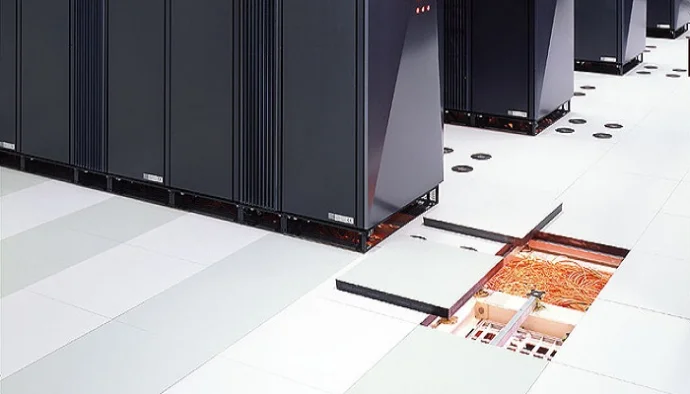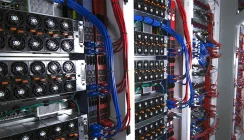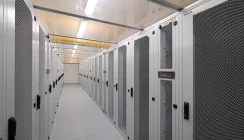What Is the Best Server Room Layout Design?
Our projects engineers come across many types of IT closets and computer room installations and are given the task of turning these into best practice server rooms. Many of these rooms start out with the best of intentions with equipment added sporadically to support new services and growth within an organisation. So how do we approach the task of achieving the best server room layout design?
Use Floor Tiles as a Guide
Some computer and serve rooms have a raised access floor or are fitted with a floor based of standard carpet tiles. The first step in designing a server room is the define the exact room dimensions, not all are square or rectangular, and to draw this up as a grid based on a standard floor tile size (typically 600×600mm). Why this approach? The answer to this lies in the use of server rack cabinets.
Build-out Using Server Rack Cabinets
Most computer and server rooms have a limited floor space but with a relatively ‘normal’ ceiling height. Using server rack cabinets, which are designed to sit into the space provided by one or more standard floor tiles allows an installation to use the least amount of floor space whilst scaling vertically.
A typical server rack cabinet will have a depth of 500, 800 or 1000mm deep and is designed to house 19inch rackmount equipment. Where a device can be mounted to the support struts, with or without slider rails, it can be sat onto a rack shelf.
Server cabinets are typically installed with side panels and may have a front and rear door. The front of the rack provides access to the front of the installed equipment with the rear used for power and network connections and exhaust air flow.
When two or more server cabinets are installed within a server room, they can be placed side by side and this helps both cabling and cooling.
Cabling Systems
With a raised access floor it is possible to use the underfloor plenum for routing power and data cables. These can be fed into the server cabinets via bottom entry compartments. Where underfloor is not an option, overhead trunking can be used.
Each power and cable connection should be mapped and identified (tagged) within the installation. This allows for easy fault finding, equipment disconnection and capacity increases in the future. Tidy cable arrangements also prevent errors when decommissioning or removing systems, especially in an emergency. Structure cabling systems can be used to tidy up multiple cable runs.
Energy Efficient Cooling
Using a server cabinet is the starting point for an energy efficient cooling system. Each generation of server provides more powerful processing and digital capacity than the next. For each 1Watt of power consumed 1Watt of heat is generated. A typical server rack even in a small server room can see 5-10kW of power draw and heat generation. Within a datacentre high power density racks can see heat loads of 15-30kW or more.
The equipment within a server rack is arranged so that cool air can be presented using precision cooling to the front of the rack. Hot air is exhausted via the rear of the cabinet. Within a server room the choice then is how to provide suitable cool and hot air flows. If the two mix, the overall efficiency of the cooling system is reduced.
A single server rack may be cooled with a wall mounted or ceiling suspended air conditioner. This is typical for a small server room. Larger installations with multiple racks may use a larger air conditioner or consider some form of containment, hot or cold aisle.
UPS Systems and Power Protection
The reliance of an organisation on its IT facilities normally dictates that the critical IT systems have 100% uptime. It is therefore good practice to install some form of uninterruptible power protection and to use smart or intelligent PDUs with metered and switched outlet sockets. The UPS and PDUs should be connected to the IP network for SNMP and data centre infrastructure management (DCIM) style monitoring and alarm reporting.
There are two types of UPS system suitable for a computer and server room installation. Line interactive UPS can be used to protect single phase servers and provide a reasonable grade of power for computer applications when mains power is present and a limited battery power supply when the mains power supply fails. The output waveform on inverter and battery power may be a sinewave or pseudo sinewave and there will be a switching period between battery and mains power.
For best practice operations, an on-line UPS system if the preferred choice. This type of UPS system is also referred to as a double-conversion or triple-conversion UPS system (AC-DC-DC or AC-DC-DC-AC). The UPS has a constantly running inverter providing a no-break electrical supply with a digitally generated sinewave output whose quality is often superior to that of the local electrical power supply. An on-line UPS can have can also offer and extended battery runtime using additional battery extension packs and has a built-in automatic bypass to ensure ‘safe failure to mains’ if the UPS develops an internal fault condition or suffers an output overload.
For additional security the UPS system should be installed with an external UPS maintenance bypass switch. This allows the UPS to be completely isolated for preventative maintenance or swapped out should fault occur, both without interruption to the connected loads.
Environment Monitoring
Computer and server rooms tend to be unmanned and may goes days without a visit. This can lead to alarms being missed which could provide fatal to the installation. Examples include a higher than normal ambient temperature within the room, high humidity or a failed UPS battery.
A best practice sever room design therefore includes environment monitoring. This may be at the room level and ideally within each server racks in at least 3-6 positions including the bottom, middle and top, front and rear.
The environment monitoring system should be connected to the local IP network and offering instant access views of the environmental aspects being monitored, as well as email and text alarm alerts.
Security
As with any IT installation, security threats are a real and growing presence, whether physical or cyber-based. Both aspects need to be addressed in the form of access control to the room itself and server cabinets and in terms of IT firewalls and software protection. Additional security can be made available through the installation of IP cable or wireless connected security cameras and the building CCTV system.
Summary
When designing a new server room or refurbishing an existing one it is important to draw everything back to the basics of the actual computing space available and how to best use the floor space to allow for day-one and future growth. Without this first principle approach it is almost impossible to achieve the most optimum energy efficiency and avoid reaching an overcomplicated and potentially messy and high-risk installation with limited room for expansion.
Please feel free to contact us for a free server room design consultation. Our engineers can map out a potential proposal following as site survey or if you prefer you can provide us with photos, a sketch and the dimensions of your server room with an equipment list to be accommodated.


























